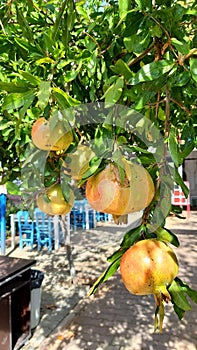- Stock Photography: POMEGRANATE FRUIT by Spektar030bor1908
- Price: 1$
- Size Facebook: 1702 x 630 px
- Size Twitter: 1500 x 500 px
- Size LinkedIn: 1128 x 191 px
More Facebook, Twitter and LinkedIn Cover Photos
Cover photo info
- Photo title: pomegranate fruit
- Author: Spektar030bor1908
- Cover photo description:
- PomegranateFruit of Punica granatum split open to reveal clusters of seeds with sarcotesta on the inside, and a glass of juiceThe pomegranate (Punica granatum) is a fruit-bearing deciduous shrub in the family Lythraceae, subfamily Punicoideae, that grows between 5 and 10 m tall.Young pomegranate tree in Side, TurkeyThe pomegranate was originally described throughout the Mediterranean region. It was introduced into Spanish America in the late 16th century and into California by Spanish settlers in 1769. They are widely cultivated throughout the Middle East and Caucasus region, north and tropical Africa, the Indian subcontinent, Central Asia, the drier parts of Southeast Asia, and the Mediterranean Basin. The fruit is typically in season in the Southern Hemisphere from March to May, and in the Northern Hemisphere from September to February.As intact sarcotestas or as juice, pomegranates are used in baking, cooking, juice blends, meal garnishes, smoothies, and alcoholic beverages, such as cocktails and wine.EtymologyA pomegranate tree in an illustration for the Tacuinum Sanitatis, made in Lombardy, late 14th century (Biblioteca Casanatense, Rome)The name pomegranate derives from medieval Latin p?mum "apple" and gr?n?tum "seeded".[7] Possibly stemming from the old French word for the fruit, pomme-grenade, the pomegranate was known in early English as "apple of Grenada"—a term which today survives only in heraldic blazons. This is a folk etymology, confusing the Latin granatus with the name of the Spanish city of Granada, which is derived from an unrelated Arabic word.[8]A shrub or small tree growing 5 to 10 m (16 to 33 ft) high, the pomegranate has multiple spiny branches and is long-lived, with some specimens in France surviving for 200 years. granatum leaves are opposite or subopposite, glossy, narrow oblong, entire, 3–7 cm long and 2 cm (3?4 in) broad. The flowers are bright red and 3 cm in diameter, with three to seven petals.[4] Some fruitless varieties are grown for the flowers alone.
- Image ID:291215760
- Views:0
- Downloads:0
Keywords for Facebook, Twitter and LinkedIn timeline photos
clusters
sarcotesta
inside
glass
conservation
status
concern
iucn
scientific
tracheophytes
angiosperms
eudicots
myrtales
family
species
binomial
name
synonyms3
florida
salisb
grandiflora
steud
spinosa
lam
rhoea
fruit
bearing
deciduous
subfamily
punicoideae
grows
side
turkey
originally
cultivated
southeast
basin
typically
season
southern
hemisphere
september
february
intact
sarcotestas
pomegranates
cooking
garnishes
smoothies
alcoholic
beverages
cocktails
wine
survives
heraldic
blazons
confusing
granatus
granada
unrelated
arabic
small
growing
multiple
branches
long
lived
flowers
red
11
4
diameter
three
petals
fruitless
varieties














